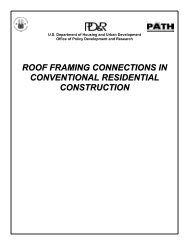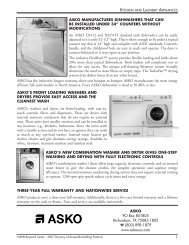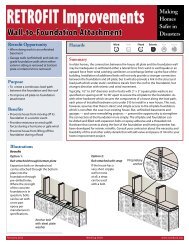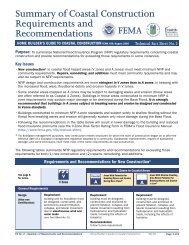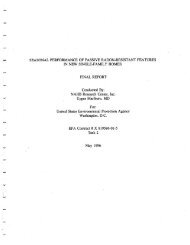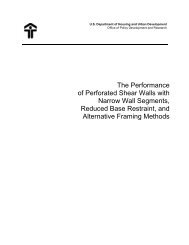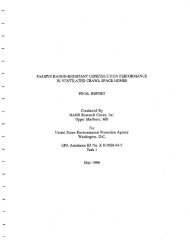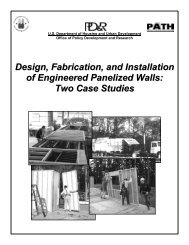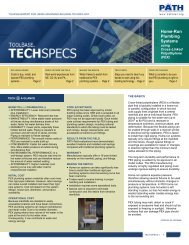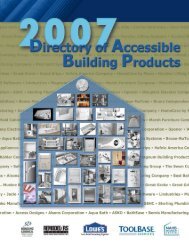Residential Construction Waste Management Demonstration and ...
Residential Construction Waste Management Demonstration and ...
Residential Construction Waste Management Demonstration and ...
You also want an ePaper? Increase the reach of your titles
YUMPU automatically turns print PDFs into web optimized ePapers that Google loves.
over 300 per cent. 4 Tipping fees in certain areas of the United States exceed $100 per<br />
ton.<br />
Federal waste regulations affect construction waste disposal by restricting disposal<br />
options <strong>and</strong> setting forth l<strong>and</strong>fill design <strong>and</strong> operation requirements. Environmental<br />
Protection Agency rules implement the Resource Conservation <strong>and</strong> Recovery Act<br />
(RCRA) 5 by addressing the treatment <strong>and</strong> disposal of solid <strong>and</strong> hazardous waste6. Under<br />
RCRA, construction <strong>and</strong> demolition waste is classified as a Subtitle D waste. The<br />
Subtitle D Program covers non-hazardous solid waste <strong>and</strong> establishes requirements for<br />
the h<strong>and</strong>ling of MSW, including MSW l<strong>and</strong>fill design <strong>and</strong> operation, but does not set<br />
any st<strong>and</strong>ards for either the h<strong>and</strong>ling of C&D waste or the design <strong>and</strong> operation of C&D<br />
l<strong>and</strong>fills Therefore, at the federal level, there are neither any apparent specific<br />
restrictions or any inducements affecting construction waste management practices.<br />
State legislation, rules, <strong>and</strong> regulations have the greatest impact on C&D waste disposal<br />
practices. This has led to wide variation in not only the definition of construction waste<br />
but also in the design <strong>and</strong> siting requirements for l<strong>and</strong>fills accepting construction waste<br />
<strong>and</strong> in penalties for the illegal disposal of construction waste. In some states, for<br />
example, jobsite burial of site-generated construction waste is acceptable, while in others<br />
it is not. Further, some states define <strong>and</strong> distinguish between MSW <strong>and</strong> C&D waste<br />
even though others do not. Consequently, the EPA rules that apply to MSW have an<br />
indirect effect on the disposal of construction waste. Differences in terms, treatment,<br />
l<strong>and</strong>fill design requirements, <strong>and</strong> penalties are important because of their impact on both<br />
disposal costs <strong>and</strong> builder practices.<br />
Even though federal, state, <strong>and</strong> local governments are devoting considerable effort to<br />
developing markets for recyclable MSW, little comparable time <strong>and</strong> money is focused<br />
on recovering, recycling, <strong>and</strong> improving markets for C&D waste materials. Many states<br />
have adopted solid waste recycling goals; others have set a cap on the portion of the<br />
4 Dixon, Byron L. A Predictive Model for the Determination of the Economic Feasibility of <strong>Construction</strong><br />
<strong>and</strong> Demolition <strong>Waste</strong> Recycling in the Air Force. Unpublished master's thesis. Air Force Institute of<br />
Technology, September 1993, AFIT/GEE/ENV/93s-05.<br />
5 Resource Conservation <strong>and</strong> Recovery Act, 42 U.S.C. 6901-6992k (1982, Suppl. III 1985). The<br />
Comprehensive Environmental Response, Compensation, <strong>and</strong> Liability Act (CERCLA or "Superfund") deals<br />
specifically with hazardous waste materials <strong>and</strong> may be relevant to a small number of specific materials<br />
generated by some residential <strong>and</strong> other light-frame construction. This element of waste management is not<br />
addressed in this study.<br />
6 40 C.F.R. 260-272 (7/1/92).<br />
'A recent court ruling (Sierra Club v. Carol M. Browner, Administrator - United States Environmental<br />
Protection Agency - Civ. No. 93-2167: Richey, J. CRR) is requiring that the EPA write rules to address smallquantity<br />
hazardous waste generation, pursuant to the Resource Recovery <strong>and</strong> Conservation Act (RCRA), section<br />
4010(c), 42 U.S.C. 6949a(c). In response, EPA will propose rules by May 15, 1995 that require minimum<br />
C&D l<strong>and</strong>fill design, siting, <strong>and</strong> operation requirements <strong>and</strong> identify hazardous materials that are unacceptable<br />
for disposal in C&D l<strong>and</strong>fills.



